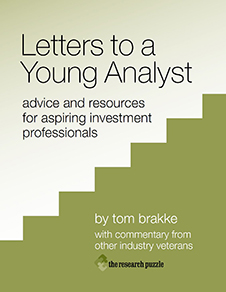
- Wednesday, September 10th, 2008
- seeking sustainability
-
Yesterday I had the luxury afforded to generalists, to be able to look across the developments in far-flung parts of the investment ecosystem, get a glimpse of current issues for each, and try to spot connections among them. At each stop along the way, there seemed to be an examination of what it takes (and means) to sustain the mission at hand.
To do that, we sometimes have to question the core tenets by which we have operated. A good example of that was the morning presentation I attended on social investments by foundations. While some of the focus was on what was traditionally called SRI (socially responsible investing) and is now often referred to using the acronym ESG (environmental, social, and governance), the most interesting topic was program-related investment (more letters — PRI). That approach is a blending of the investment function of the foundation and its programmatic mission. The kicker for an investment person is that such investments are made at below-market rates when adjusted for risk.
How are we to think about such things? The desire is to further the work of the foundation (and give it the long-term impact that was sought by its benefactors), but how should we make decisions — outside of or within the analytical boxes that we are used to using? A PRI investment may cause our overall results to suffer versus those of others, a sort of philosophical haircut of a style that we have chosen. What are the ramifications of that?
The rich mix of concerns and adjustments that come from such decisions are not new (on one front, think of the debate over the State of Alabama’s investment in the Robert Trent Jones Golf Trail to try to attract tourists), but they are intensifying. Investment advisers and others that might find themselves at the intersection of portfolio and purpose will need to have good answers to the relevant questions or they will see their business move to those that do.
Interestingly, many of those same foundations are counting on alternative investments to drive their returns, and later in the day I attended a seminar on “sound” hedge fund practices. Given the tumultuous times in that end of the market, there was much to discuss. It is not a stretch (to fit the title of this posting) to say that the theme of the event was sustainability. Investors are questioning whether the performance pattern they thought they were getting will really be there over time, or even whether the managers they have chosen will be there to fight another day. For the firms, every aspect of what they do is under external scrutiny and internal review, from portfolio strategy to operations to compliance to client relations. Twelve years ago when I first studied these types of investments, I thought that significant improvements were needed across each of these areas for hedge funds to become truly institutionalized. The best firms have done so, but the industry is now suffering from the fact that careful attention usually gets paid to some of these things only when circumstances force them to the foreground.
Between those book-ended meetings, I hit the books at the local university. On a beautiful day with a whiff of fall, I made my way to the library, a path somehow more easily trod at an advanced age. There I examined historical asset returns (the subject of a future posting) and mulled their role in the plans we envision for ourselves, those that depend on us, and our organizations.
The real reason for the campus trip was to visit those seeking to train the next generation of investment professionals. There are more than three hundred student-run investment funds in the United States alone, and these vehicles serve to attract students and provide an avenue for them to enter the business, hopefully while generating a return on the portfolio under management. This blossoming of programs has reached a point where it’s time to ask some pointed questions: Are they “working”? What is it that is actually being taught to these students? By whom? Are the goals of the students, the schools, and the employers being met?
Across the disparate elements of the day we can see further questions: What is transitory? What is fundamental and foundational? What are the assumptions that we have made about operating in our corner of the investment world that will not stand the test of time? And, yes, what is sustainable?
